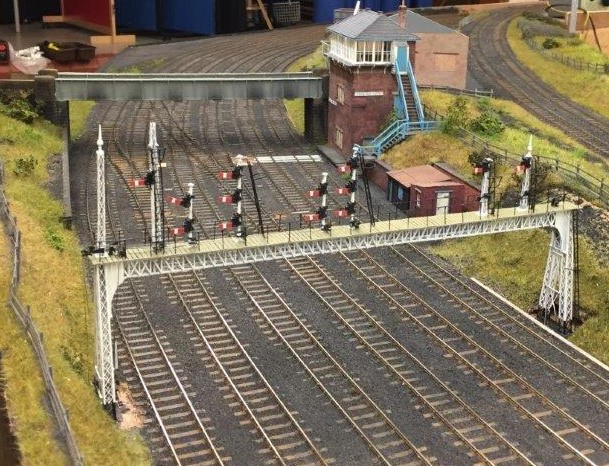A suspiciously clean Q6 pulls a short freight up the hill towards Consett. Note the ex NER snowploughs in the siding - scratchbuilt by Pete with some inspiration from Worsdell Forever on RMweb.
An O1 waits on the Down Washington for another banking duty. This picture shows some of the progress in this area with 'Pete's bridge' bedded into the scenery and the NCB spoil tip created.
A 9F prepares to tackle the severe gradients on the Up Consett with a loaded iron ore train. Some newly installed signals are shown to advantage, with Martin's No 62/67 bracket signal on the left, controlling movements from the Down Consett towards Ouston Jn (left) or right towards Washington. No 62 (the left arm) is an ex NER slotted post lower quadrant, while no 67 (right) is an upper quadrant mounted on a wooden doll - I'm sure this kind of combination wouldn't be allowed nowadays. On the right we have Richard's superb lattice cantilever bracket with signals 85, 84, 79 and 78 controlling movements from Stella Gill roads No2 Outgoing, No 3 Outgoing and No 3 Incoming.
A busy scene at South Pelaw with a pair of 9Fs starting the hard work up the hill to South Medomsley Junction (where the bankers uncoupled, next to Eden Colliery) while an O1 hauls a set of empty iron ore hoppers en route to Tyne Dock. In Stella Gill No 1 Outgoing road, a Wilson Worsdell N9 shunts a loaded rake of mineral hoppers.
A 9F stands outside South Pelaw box awaiting further instructions. Mark's labour of love on the signalbox continues, with the interior work complete he has turned his attention to completing the exterior. The ornate cast-iron brackets which supported the balcony are gradually being added - the product of a detailed drawing by Mark and laser cutting by York Modelmaking.
Just to show we do allow the odd diesel to appear, a Clayton plus brake tender emerges from Pelton Lane bridge with a mixed freight in tow.


















